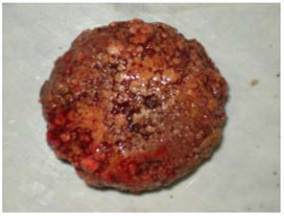Basic HTML Version







International Journal of Molecular Veterinary Research
2013, Vol.3, No.4, 9-12
http://ijmvr.sophiapublisher.com
11
ultrasonogram and the image of the os penis could be
seen as a thin line (Figure 5).
Figure 3 Nephroliths
Figure 4 Cystoliths
Figure 5 Urethroliths
3 Surgical Management
Dogs were immediately prepared for aseptic surgery.
Xylazine @ 1~2 mg/kg and ketamine @ 3~5 mg/kg
were combined for induction as well as maintenance
of anaesthesia. Skin was incised posterior to os-penis
and urethra was opened to remove calculi. All the
calculi could not be removed through this incision site.
Urethrotomy was done at three different sites to remove
rows of multiple calculi. These calculi are shown in the
picture (Figure 6). A polyethylene catheter was passed
from penile urethra to urinary bladder after clearance
of urethra from calculi. Urethra, overlying muscles
and skin were closed in routine manner.
Figure 6 Gross appearance of Urethroliths
To remove cystoliths, para-median cystotomy was
done. The abdominal cavity was opened parallel to
penis through para-median incision (Figure 7).
Figure 7 Paramedian cystotomy incision
Figure 8 Gross apprearance of Cystoliths
Urinary bladder was taken out through this incision.
Cystotomy was done to remove multiple calculi of
different shapes and size. The shape of the calculi
varies from oval, rectangular to round (Figure 8).
The surface of these calculi was from smooth to
granular. Cystorrhaphy was done to close the
incision after removal of calculi. Peritoneum,
muscles and skin were repaired in routine manner.
Postoperatively, the dogs were administered full
course of antibiotics, analgesics, anti-inflammatory
drugs along with fluid and B-complex. Oral urinary
antiseptic cystone was given for 20 days. Antiseptic

